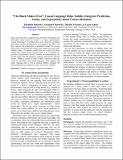"The Block Makes It Go": Causal Language Helps Toddlers Integrate Prediction, Action, and Expectations about Contact Relations
Author(s)
Bonawitz, Elizabeth; Horowitz, Alexandra; Ferranti, Darlene; Schulz, Laura E.
DownloadBonawitzHorowitzFerrantiSchulzFinal2.pdf (181.2Kb)
OPEN_ACCESS_POLICY
Open Access Policy
Creative Commons Attribution-Noncommercial-Share Alike
Terms of use
Metadata
Show full item recordAbstract
Some researchers have suggested that correlation information and
information about action are bound in a single representation:
“causal knowledge”. If children have only observed correlation
information, do they spontaneously try to generate the effect? Do
they represent the relationship as potentially causal? We present
three action and looking-time studies that suggest that even when
toddlers (mean; 24 months) predict that one event will follow
another, they neither initiate the first event to try to generate the
second (as preschoolers, mean 47 months, do spontaneously), nor
do they expect that the predictive relations will involve physical
contact. Toddlers succeed at both of these inferences when the
events are described using causal language. This suggests that
causal language plays a role in helping children recognize the
relationship between prediction, action, and contact causality.
Date issued
2009-07Department
Massachusetts Institute of Technology. Department of Brain and Cognitive SciencesJournal
Proceedings of the 31st Annual Conference of the Cognitive Science Society
Publisher
Cognitive Science Society (U.S.)
Citation
Bonawitz, Elizabeth Baraff, Alexandra Horowitz, Darlene Ferranti, and Laura Schulz. "The Block Makes It Go: Causal Language Helps Toddlers Integrate Prediction, Action, and
Expectations about Contact Relations." in Proceedings of the 31st Annual Conference of the Cognitive Science Society, July 29-August 1, 2009, Vrije Universiteit, Amsterdam, Netherlands, Niels Taatgen and Hedderik van Rijn, Editors, 2009.
Version: Author's final manuscript
ISBN
978-0-9768318-5-3